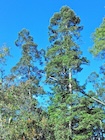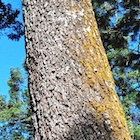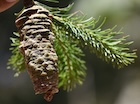Conservation Status

Abies jaliscana
(Martínez) Mantilla, Shalisko & A. Vázquez (2014)
Common names
None. In Mexico, the species is likely regarded as a typical fir and thus would usually be called Abeto, Pinabete, or perhaps Oyamel. Abeto de Jalisco would be a logical common name. The logical English name would be Jalisco fir.
Taxonomic notes
Type: Mexico, Jalisco, Mun. Talpa [de Allende, Rincon de] La Mesa, cerca de Cuale [5-9 km, 1800 m], Nov 1947, M. Martínez [& A. Q. González] 28500 [numbered by Maximino Martínez]. Lectotype: MEXU (no. 545019); isolectotype: MEXU (no. 2707). Syn.: Abies guatemalensis Rehder var. jaliscana Martínez 1948 (pro parte); A. guatemalensis subsp. jaliscana (Martínez) Silba 2008 (pro parte).
This is a member of Abies section Grandis. See Abies religiosa for general notes on the Mexican and Mesoamerican firs, including the relationship between A. flinckii and A. jaliscana. Vázquez-García et al. (2014) describe a rationale for assigning species status to this taxon, which had previously been treated within Abies guatemalensis or A. flinckii. Accrual of molecular evidence has since established A. jaliscana as a good species (Cruz-Nicolás et al. 2020), although its sister relationship to A. flinckii suggests that it could be regarded as a subspecies of that taxon.
Description
Trees to 100 cm dbh and 30 m tall; branching not described. Bark gray-brown, with age dividing into irregular plates. Twigs reddish brown, pubescent, sometimes densely so. Buds not described. Leaves pectinate, lax, bright green on upper surface, glaucous beneath, (20-)35-80(-90) × 0.8-1.5 mm, length sometimes varying by 2× within a single shoot, twisted at the base, apex emarginate or obtuse (rarely acute). Stomata borne on lower surface in 10-12 rows in 2 bands, and also on upper surface in 3-4 discontinuous rows near the apex. Pollen cones 9-17 × 4.4-6.1 mm, otherwise not described. Mature seed cones borne on peduncles up to 1 cm long, subcylindrical or ellipsoid, apex blunt, (5-)6-10(-12) × 2.5-4(-4.4) cm, with a length/width ratio of 2.3-2.9; green or purplish to dark brown. Rachis conical, 4.2-5.4 mm thick at base, 7-10 cm long. Ovuliferous scales reniform, thin, proximally concave, distal margin reflexed, 18-25 mm wide, 14-17 mm long, with subentire or irregularly erose lateral margins; bracts appearing almost included in mature cones (northern populations), two-thirds as long as the scales or about equaling them, to exserted in mature cones with the exposed part up to 4 mm long, denticulate marginally, bearing a minute, acute cusp, terminating in a short point 0.5-1.2 mm long. Seed cuneate, 9-10 × 6-8 mm with a 14-15 mm light brown wing. Anthesis occurs from late November into January; cones become ripe in April-May, dispersing in May-June (Vázquez-García et al. 2014).
Vázquez-García et al. (2014) distinguish A. flinckii and A. jaliscana from other Abies of western Mexico (A. durangensis, A. religiosa) by their long leaves, 35-70(-90) mm long, apex obtuse or emarginate, and a seed cone length/width ratio of 2.5 or greater. A. flinckii and A. jaliscana can be distinguished as follows:
- A. flinckii: cones olive-green, 12-16 × 4-4.5 cm; cone length/width ratio 2.9-3.4; ovuliferous scales with flabellate, erose margins 2.5-2.7 × 3-4 cm and exserted and spreading bract scales, in anthesis February-March; receptive female strobili 7 × 2.4 cm, ripening in November; pollen cones 30-40 × 7 mm; leaves >1.5 mm wide.
- A. jaliscana: cones green or purplish, 5-12 × 2.5-4 cm; cone length/width ratio (2.4-)2.5-2.8; ovuliferous scales reniform, concave in the beginning and reflexed outward 1.8-2 × 2-2.5 cm and exserted or included bract scales, in anthesis November-January; receptive female strobili 3.5 × 1.5 cm, ripening in late April-May; pollen cones 9-17 × 44-61 mm; leaves <1.5 mm wide.
Distribution and Ecology
Mexico: western Jalisco. Occurs at elevations of 1580-2400 m on steep mountainsides and humid ravines, on seaward and north facing slopes. Does not occur with other species of Abies; ecological associations not otherwise described. The IUCN classifies A. jaliscana as "Near Threatened" due primarily to its limited extent of occurrence and area of occupancy. However, that assessment apparently conflates A. jaliscana with A. flinckii, and thus overestimates both extent of occurrence and area of occupancy. Since it is the less common of the two taxa, A. jaliscana could well qualify as "Threatened".
Distribution of Abies flinckii and A. jaliscana. Data downloaded 2023.11.25 from GBIF; see description in map (click on tray icon) for further detail; click on points for further data.
Remarkable Specimens
No data as of 2025.01.21.
Ethnobotany
Given the very localized distribution of this species, it is unlikely that indigenous people distinguished it from other Mexican firs, and it was likely put to the same uses as more widespread taxa, such as Abies religiosa, which occurs farther east in Jalisco.
Observations
No data as of 2023.11.25, except that there are a number of observations recorded on iNaturalist.
Remarks
The epithet acknowledges Jalisco, where this species is endemic (Vázquez-García et al. 2014).
Citations
Aguirre-Planter, Érika, Juan P. Jaramillo-Correa, Sandra Gómez-Acevedo, Damase P. Khasa, Jean Bousquet, and Luis E. Eguiarte. 2012. Phylogeny, diversification rates and species boundaries of Mesoamerican firs (Abies, Pinaceae) in a genus-wide context. Molecular Phylogenetics and Evolution 62(1):263-274.
Cruz-Nicolás, Jorge, Gustavo Giles-Pérez, Eréndira González-Linares, Julia Múgica-Gallart, Andrés Lira-Noriega, David S. Gernandt, Luis E. Eguiarte, and Juan P. Jaramillo-Correa. 2020. Contrasting evolutionary processes drive morphological and genetic differentiation in a subtropical fir (Abies, Pinaceae) species complex. Botanical Journal of the Linnean Society 192(2):401-420.
Mantilla, Shalisko & A. Vázquez 2014: See p. 28 in Vázquez-García et al. (2014).
Semerikova, Svetlana A., Yuliya Y. Khrunyk, Martin Lascoux, and Vladimir L. Semerikov. 2018. From America to Eurasia: A multigenomes history of the genus Abies. Molecular Phylogenetics and Evolution 125:14-28. https://doi.org/10.1016/j.ympev.2018.03.009.
Vazquez-García, J. Antonio, Viacheslav Shalisko, Ramon Cuevas-Guzmán, Miguel A. Muñiz-Castro, and Mauricio R. Manilla-Blandón. 2014. Abies jaliscana (Pinaceae): A new combination in section Grandis and a key to the species of Abies in western Mexico. Phytotaxa 183(1):27-36.
Xiang, Qiao-Ping, Ran Wei, Yi-Zhen Shao, Zu-Yu Yang, Xiao-Quan Wang, and Xian-Chun Zhang. 2015. Phylogenetic relationships, possible ancient hybridization, and biogeographic history of Abies (Pinaceae) based on data from nuclear, plastid, and mitochondrial genomes. Molecular Phylogenetics and Evolution 82:1-14. https://doi.org/10.1016/j.ympev.2014.10.008.
Xiang, Qiao‐Ping, Ran Wei, Yan‐Mei Zhu, A. J. Harris, and Xian‐Chun Zhang. 2018. New infrageneric classification of Abies in light of molecular phylogeny and high diversity in western North America. Journal of Systematics and Evolution 56(5):562-72. https://doi.org/10.1111/jse.12458.
See also
The species account at Threatened Conifers of the World.





